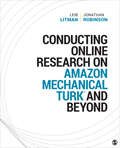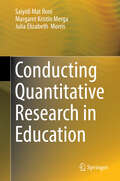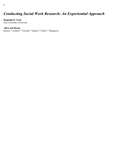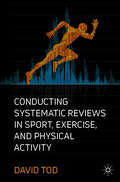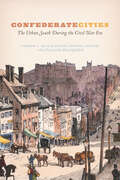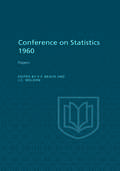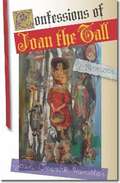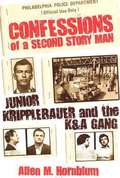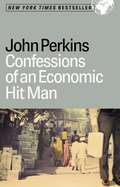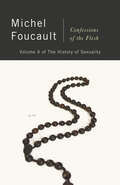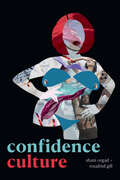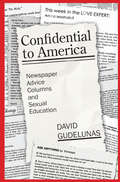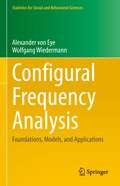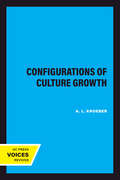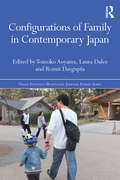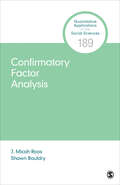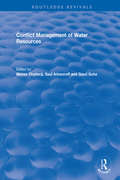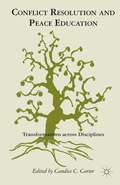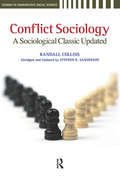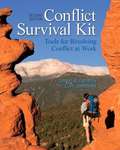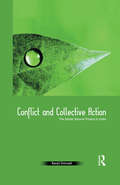- Table View
- List View
Conducting Online Research on Amazon Mechanical Turk and Beyond (SAGE Innovations in Research Methods #1)
by Jonathan Robinson Leib LitmanConducting Online Research on Amazon Mechanical Turk® and Beyond, written by Leib Litman and Jonathan Robinson, provides both students and experienced researchers with essential information about the online platforms most often used for social science research. This insightful and accessible text answers common questions like, "How do I maintain data quality in online studies?," "What is the best way to recruit hard-to-reach samples?" and "How can researchers navigate the ethical issues that are unique to online research?" Drawing on their experiences as the founders of CloudResearch (formerly TurkPrime), the authors provide information that guides new users planning their first online studies and engages even the most experienced researchers with detailed discussions about the challenges of online research. The book begins with an overview of Amazon’s Mechanical Turk and its rapid rise within academic research. Then, the authors describe how to set up an MTurk study with screenshots that walk readers through the steps of creating an account, designing a study, collecting data, and using third-party applications to enhance MTurk’s functionality. Later chapters provide readers with a detailed understanding of the MTurk environment and use data from hundreds of thousands of participants and tens of millions of completed tasks to dive into issues like participant demographics, sources of sampling bias, and the generalizability of findings from MTurk. Finally, the book explores the benefits of using other online platforms as a complement to MTurk and the ethical issues that are unique to conducting research with online participant platforms. Throughout the book, the authors share hands-on advice and best practices, such as those for conducting longitudinal studies or carrying out complex studies. Altogether the mix of data, insight, and advice make this book an essential resource for researchers who want to understand the online environment and the most effective ways to conduct research online.
Conducting Quantitative Research in Education
by Margaret Kristin Merga Julia Elizabeth Morris Saiyidi Mat RoniThis book provides a clear and straightforward guide for all those seeking to conduct quantitative research in the field of education, using primary research data samples. While positioned as less powerful and somehow inferior, non-parametric tests can be very useful where the research can only be designed to accommodate data structure which is ordinal, or scale but violates a normality assumption, which is required for parametric tests. Non-parametric data are a staple of educational research, and as such, it is essential that educational researchers learn how to work with these data with confidence and rigour.
Conducting Social Work Research: An Experiential Approach
by Reginald O. YorkKEY BENEFIT: Social workers at any level in the profession will find this reference extremely helpful as they foray into the ever-increasing important research stage of their careers. As the need and desire for social workers continue to increase, this book will help those learn the proper ways to conduct research in the field. Readers are given information on specific tasks in research in which they will be called upon to evaluate alternative ways to complete each task in the research process. this book focuses on the purposes of research and the entire research process. Social workers.
Conducting Systematic Reviews in Sport, Exercise, and Physical Activity
by David TodThis book offers a conceptual and practical guide to the systematic review process and its application to sport, exercise, and physical activity research. It begins by describing what systematic reviews are and why they assist scientists and practitioners. Providing step-by-step instructions the author leads readers through the process, including generation of suitable review questions; development and implementation of search strategies; data extraction and analysis; theoretical interpretation; and result dissemination.Conducting Systematic Reviews in Sport, Exercise, and Physical Activity clarifies several common misunderstandings including the difference between qualitative systematic reviews and meta-analyses . Each chapter begins with a set of learning objectives focused on practical application, illustrated with examples from reviews published within the sport, exercise, and physical activity fields. Once a reader has completed all the learning activities along the way, they will have designed a systematic review and have written a protocol ready for registration. The book ends with a collection of advice from internationally regarded scientists with substantial experience in systematic reviews.
Confederate Cities: The Urban South during the Civil War Era (Historical Studies of Urban America)
by Andrew L. Slap Frank TowersWhen we talk about the Civil War, we often describe it in terms of battles that took place in small towns or in the countryside: Antietam, Gettysburg, Bull Run, and, most tellingly, the Battle of the Wilderness. One reason this picture has persisted is that few urban historians have studied the war, even though cities hosted, enabled, and shaped Southern society as much as they did in the North. Confederate Cities, edited by Andrew L. Slap and Frank Towers, shifts the focus from the agrarian economy that undergirded the South to the cities that served as its political and administrative hubs. The contributors use the lens of the city to examine now-familiar Civil War-era themes, including the scope of the war, secession, gender, emancipation, and war's destruction. This more integrative approach dramatically revises our understanding of slavery's relationship to capitalist economics and cultural modernity. By enabling a more holistic reading of the South, the book speaks to contemporary Civil War scholars and students alike--not least in providing fresh perspectives on a well-studied war.
Conference on Statistics 1960
by J. C. Weldon E. F. BeachIn 1958 the Canadian Political Science Association established a committee to look into ways and means of improving statistical research in the social sciences in Canada. One of the ways in which the committee thought this could be done was by establishing an annual forum where papers could be presented and discussed. Eight papers given at the first Conference at Queen's University are contained in this volume. Diverse alike in subject and statistical method---as indeed a collection of papers reflecting the purpose of the founding committee is bound to be---the papers as printed incorporate the discussion that attended their presentation in 1960.The papers are: K.A.H. Buckley, "Historical Estimates of Internal Migration in Canada,"; Richard E. Du Wurs, Robert Batson, Margaret Daffron, "The 'Mass Society' and 'Community' Analyses of the Social Present"; P.J. Giffen, "Canadian Criminal Statistics"; E.J. Hanson, "The Post-war Rise of the Crude Petroleum Industry"; Gideon Rosenbluth, "Salaries of Engineers and Scientists, 1951"; David N. Solomon, Agnes M. Fergusson, "The Distribution and Functions of Canadian Engineers and Scientists"; K.W. Studnicki-Gizbert, "The Structure and Growth of the Canadian Air Transport Industry"; T.R. Vout, "The Canadian Manufacturing Industry, 1900-57."
Confessions of Joan The Tall
by Joan Cusack HandlerFreedom and awakening of an adolescent, Bronx bred, Irish Catholic girl.
Confessions of a Second Story Man: Junior Kripplebauer and the K&A Gang
by Allen M. HornblumFrom the 1950s to the 1970s, from Bar Harbor to Boca Raton, the ragtag crew known as the K&A Gang robbed wealthy suburban neighborhoods with assembly line skills. It was hard to imagine a more unlikely crew of successful thieves, writes Allen Hornblum. [They were] two-fisted, beer-guzzling, ear- and nose-biting hoodlums from a blue collar section of Philadelphia called Kensington. The gang infuriated homeowners up and down the East Coast, while baffling police. Confessions of a Second Story Man follows the gang as they move in and out of homes, courtrooms, and prisons, and even go on the run. Hornblum describes the transformation of the K&A Gang from a group of blue collar thieves to their work in conjunction with numerous organized crime families and their role in making Philadelphia the meth capitol of the nation. It is a compelling read about a fascinating bunch of hoodlums.
Confessions of a Sociopath: A Life Spent Hiding in Plain Sight
by M. E. ThomasAs M.E. Thomas says of her fellow sociopaths, we are your neighbors, co-workers, and quite possibly the people closest to you: lovers, family, friends. Our risk-seeking behavior and general fearlessness are thrilling, our glibness and charm alluring. Our often quick wit and outside-the-box thinking make us appear intelligent--even brilliant. We climb the corporate ladder faster than the rest, and appear to have limitless self-confidence. Who are we? We are highly successful, non-criminal sociopaths and we comprise 4% of the American population (that's 1 in 25 people!). Confessions of a Sociopath takes readers on a journey into the mind of a sociopath, revealing what makes the tick and what that means for the rest of humanity. Written from the point of view of a diagnosed sociopath, it unveils these men and women who are "hiding in plain sight" for the very first time. Confessions of a Sociopath is part confessional memoir, part primer for the wary. Drawn from Thomas' own experiences; her popular blog, Sociopathworld.com; and current and historical scientific literature, it reveals just how different - and yet often very similar - sociopaths are from the rest of the world. The book confirms suspicions and debunks myths about sociopathy and is both the memoir of a high-functioning, law-abiding (well, mostly) sociopath and a roadmap - right from the source - for dealing with the sociopath in your life, be it a boss, sibling, parent, spouse, child, neighbor, colleague or friend. As Thomas argues, while sociopaths aren't like everyone else, and it's true some of them are incredibly dangerous, they are not inherently evil. In fact, they're potentially more productive and useful to society than neurotypicals or "empaths," as they fondly like to call "normal" people. Confessions of a Sociopath demystifyies sociopathic behavior and provide readers with greater insight on how to respond or react to protect themselves, live among sociopaths without becoming victims, and even beat sociopaths at their own game, through a bit of empathetic cunning and manipulation.
Confessions of an AI Brain
by Paul Pettersson Elena Fersman Athanasios KarapantelakisHave you thought of how it feels to be an AI brain in the world of humans? This book allows such a brain to tell us how it takes on its mission of helping humans to develop a more efficient, sustainable, diverse and inclusive society.This book explains the principles and applications of artificial intelligence for a broad audience. Artificial intelligence, as part of computer science, is often inspired by human intelligence. At the same time, there is still reluctance in the applications and usability of artificial intelligence among citizens. Industries are deploying AI in their products and processes but the level of maturity is varying. The book is written as a first person narrative, from an AI perspective, having the AI brain tell the story.
Confessions of an Economic Hit Man
by John PerkinsThis is the story of John Perkins and his involvement in the behind the scenes business and political work as U.S corporations have attempted to dominate and control the world economy. This story crosses many administrations and how John was involved in major policies since 1970. These are his experiences and he reveals the underhanded ways we have taken over many national economies world wide.
Confessions of an Ex-Bachelor: How To Sift Through All the Game Players to Find Mr. Right
by William July IIThe popular relationship guru blows the whistle on perpetual bachelors, with wise words for women seeking nuptial-minded men.A male radio host once chided William July for being so open about the playboy mentality. “Man, stop giving away all of our secrets to the women,” the host said. But July, who has been happily married for six years, believes that this kind of secrecy and game playing is harmful to everyone. A self-proclaimed former “General in the Bachelor Corps,” July now openly reveals the tricks of the bachelor trade to help women find guys who are genuinely ready for commitment. Confessions of an Ex-Bachelor delivers no-nonsense dialogue on:• The three stages of bachelorhood, and how to tell whether your date will ever graduate past groom-a-phobia• How to hold your man accountable and stand your ground—without making him feel trapped• Overcoming cultural cues that make men see marriage as a life in chains• Where to find your future groom• How to translate a bachelor’s double-talk• Getting past the stereotypes of divorced men, “nice guys,” and how men feel about being stepfathersA must read for every single woman who wonders what her guy is really thinking, Confessions of an Ex-Bachelor is full of revelations and rewarding advice.
Confessions of the Flesh: The History of Sexuality, Volume 4
by Michel FoucaultThe fourth and final volume in Michel Foucault&’s acclaimed History of Sexuality, completed just before his death in 1984 and finally available to the public One of the most influential thinkers of the twentieth century, Michel Foucault made an indelible impact on Western thought. The first three volumes in his History of Sexuality—which trace cultural and intellectual notions of sexuality, arguing that it has been profoundly shaped by the power structures applied to it—constitute some of Foucault&’s most important work. This fourth volume posits that the origins of totalitarian self-surveillance began with the Christian practice of confession. The manuscript had long been secreted away, in accordance with Foucault&’s stated wish that there be no posthumous publication of his unpublished work. With the sale of the Foucault archives in 2013, Foucault&’s nephew felt that the time had come to publish this final volume in Foucault&’s seminal history. Philosophically, it is a chapter in his hermeneutics of the desiring subject. Historically, it focuses on the remodeling of subjectivity carried out by the early Christian Fathers, who set out to transform the classical Logos of truthful human discourse into a theologos—the divine Word of a pure sovereign. What did God will in the matter of righteous sexual practice? Foucault parses out the logic of the various responses proffered by theologians over the centuries, culminating with Saint Augustine&’s fascinating discussion of the libido. Sweeping and deeply personal, Confessions of the Flesh is a tour de force from a philosophical master
Confidence Culture
by Shani Orgad Rosalind GillIn Confidence Culture, Shani Orgad and Rosalind Gill argue that imperatives directed at women to “love your body” and “believe in yourself” imply that psychological blocks rather than entrenched social injustices hold women back. Interrogating the prominence of confidence in contemporary discourse about body image, workplace, relationships, motherhood, and international development, Orgad and Gill draw on Foucault’s notion of technologies of self to demonstrate how “confidence culture” demands of women near-constant introspection and vigilance in the service of self-improvement. They argue that while confidence messaging may feel good, it does not address structural and systemic oppression. Rather, confidence culture suggests that women—along with people of color, the disabled, and other marginalized groups—are responsible for their own conditions. Rejecting confidence culture’s remaking of feminism along individualistic and neoliberal lines, Orgad and Gill explore alternative articulations of feminism that go beyond the confidence imperative.
Confidential to America: Newspaper Advice Columns and Sexual Education
by David GudelunasIn modern-day America, newspaper advice columns have become public forums for the discussion of human sexuality. Although questions posed to newspaper advice columnists ranges from matters of etiquette to intimacy, as they have for decades, increasingly most of the limited space in these newspaper features address issues that fall under a broader heading of sexuality. Questions about marital fidelity, dating and relationships, sexual practices, gender roles, and sexual taboos have all become "hot button" topics within the morally conservative mainstream press. In Confidential to America, David Gudelunas shows how, since the 1950s, advice columns have been one of the few consistent, mainstream, and widely available public forums for the discussion of topics severely restricted in other places.Newspaper advice columns serve as sites of discussion about sexuality within a larger culture that is severely divided on questions of how, when, and to what extent one may formally speak about sexuality. Even now, at the turn of the twenty-first century, high schools remain hesitant to devote more than a semester or two to formal discussions of sexuality. When they do, under current governmental policy and pressure, these discussions are often restricted to abstinence-only programs or what might be described as "non-discussions" of sexuality. Community-based sexual education programs are similarly restricted in their reach, funding, and, more often than not, effectiveness. In America in the twenty-first century, talking about sex in educational contexts is perceived to be almost as risky as having sex.Gudelunas demonstrates that while formal discussions of sexuality are strictly regulated and often thwarted, the informal curriculum of sexuality, particularly in the American mass media, has become ever more vocal on the topic of sex. From depictions conveyed through fictional and reality-based popular culture, to discussions taking place in the cafeteria (if not the classroom) and in Internet chat rooms, sexuality dominates our collective conscience.
Configural Frequency Analysis: Foundations, Models, and Applications (Statistics for Social and Behavioral Sciences)
by Wolfgang Wiedermann Alexander von EyeThis unique book provides a comprehensive and detailed coverage of configural frequency analysis (CFA), the most useful method of analysis of categorical data in person-oriented research. It presents the foundations, methods, and models of CFA and features numerous empirical data examples from a range of disciplines that can be reproduced by the readers. It also addresses computer applications, including relevant R packages and modules.Configural frequency analysis is a statistical method that allows the processing of important and interesting questions in categorical data. The perspective of CFA differs from the usual perspective of relations among variables; its focus is on patterns of variable categories that stand out with respect to specific hypotheses, and as such, CFA allows for testing numerous substantive hypotheses.The book describes the origins of CFA and their relation to chi-square analysis as well as the developments that are based on log-linear modeling. The models covered range from simple models of variable independence to complex models that are needed when causal hypotheses are tested. Empirical data examples are provided for each model. New models are introduced for person-oriented mediation analysis and locally optimized time series analysis, and new results concerning the characteristics of CFA methods are bolstered using Monte Carlo simulations.Primarily intended for researchers and students in the social and behavioral sciences, the book will also appeal to anyone who deals with categorical data from a person-centered perspective.
Configurations of Culture Growth
by A. L. Kroeber"This handsome volume, one of a group commemorating the seventy-fifth anniversary of the University of California, caps the prolific and extraordinarily varied publications of the most distinguished of living American anthropologists.... In this book [Kroeber] demonstrates his control over amazing ranges of world history. Kroeber's versatility and intellectual robustness are all the more refreshing when viewed against the background of the narrowness and overspecialization, the relative isolation from the main currents of contemporary thought, and the inbred parochialism which have, on the whole, characterized twentieth-century anthropology. Configurations of Culture Growth deserves those abused adjectives 'great' and 'monumental.' " From: Clyde Kluckhohn 1946 review of "Configurations of Culture Growth."American Journal of Sociology, vol. 51, no. 4, p. 336-341.
Configurations of Family in Contemporary Japan (Nissan Institute/Routledge Japanese Studies)
by Tomoko Aoyama Laura Dales Romit DasguptaThe middle-class nuclear family model has long dominated discourses on family in Japan. Yet there have always been multiple configurations of family and kinship, which, in the context of significant socio-economic and demographic shifts since the 1990s, have become increasingly visible in public discourse. This book explores the meanings and practices of "family" in Japan, and brings together research by scholars of literature, gender studies, media and cultural studies, sociology and anthropology. While the primary focus is the "Japanese" family, it also examines the experience and practice of family beyond the borders of Japan, in such settings as Brazil, Australia, and Bali. The chapters explore key issues such as ageing, single households, non-heterosexual living arrangements and parenting. Moreover, many of the issues addressed, such as the growing diversity of family, the increase in single-person households, and the implications of an ageing society, are applicable to other mature, late-industrial societies. Employing both multi- and inter-disciplinary approaches, this book combines textual analysis of contemporary television, film, literature, manga, anime and other media with empirical and ethnographic studies of families in Japan and in transnational spaces. As such, it will be of great interest to students and scholars working across a number of fields including Japanese culture and society, sociology of family, gender studies, film and media studies, literature and cultural studies, and gerontology.
Confirmatory Factor Analysis (Quantitative Applications in the Social Sciences)
by J. Micah Roos Shawn BauldryMeasurement connects theoretical concepts to what is observable in the empirical world, and is fundamental to all social and behavioral research. In this volume, J. Micah Roos and Shawn Bauldry introduce a popular approach to measurement: Confirmatory Factor Analysis (CFA). As the authors explain, CFA is a theoretically informed statistical framework for linking multiple observed variables to latent variables that are not directly measurable. The authors begin by defining terms, introducing notation, and illustrating a wide variety of measurement models with different relationships between latent and observed variables. They proceed to a thorough treatment of model estimation, followed by a discussion of model fit. Most of the volume focuses on measures that approximate continuous variables, but the authors also devote a chapter to categorical indicators. Each chapter develops a different example (sometimes two) covering topics as diverse as racist attitudes, theological conservatism, leadership qualities, psychological distress, self-efficacy, beliefs about democracy, and Christian nationalism drawn mainly from national surveys. Data to replicate the examples are available on a companion website, along with code for R, Stata, and Mplus.
Confirmatory Factor Analysis (Quantitative Applications in the Social Sciences)
by J. Micah Roos Shawn BauldryMeasurement connects theoretical concepts to what is observable in the empirical world, and is fundamental to all social and behavioral research. In this volume, J. Micah Roos and Shawn Bauldry introduce a popular approach to measurement: Confirmatory Factor Analysis (CFA). As the authors explain, CFA is a theoretically informed statistical framework for linking multiple observed variables to latent variables that are not directly measurable. The authors begin by defining terms, introducing notation, and illustrating a wide variety of measurement models with different relationships between latent and observed variables. They proceed to a thorough treatment of model estimation, followed by a discussion of model fit. Most of the volume focuses on measures that approximate continuous variables, but the authors also devote a chapter to categorical indicators. Each chapter develops a different example (sometimes two) covering topics as diverse as racist attitudes, theological conservatism, leadership qualities, psychological distress, self-efficacy, beliefs about democracy, and Christian nationalism drawn mainly from national surveys. Data to replicate the examples are available on a companion website, along with code for R, Stata, and Mplus.
Conflict Management of Water Resources (Routledge Revivals)
by Manas Chatterji Saul Arlosoroff Gauri GuhaThis title was first published in 2002: Now that the Cold War is over, ethnic and regional conflicts are emerging over resources and the environment. The management of water, the lifeblood of any country, is becoming a vital issue. This volume offers a study of conflict management of water resources. It includes some selected papers presented at an international meeting, held at the Mahatma Gandhi Center of Conflict Prevention and Management in Ahmedabad, India. Other invited papers have also been included in the collection. Obviously it was not possible to address here all aspects of the vast field of water management. The main focus of this work is the management of water conflict and its implications for peace.
Conflict Resolution and Peace Education
by Candice C. CarterPeace education includes lessons about conflict sources, transformation and resolution. While featuring field-based examples in multiple disciplines, including political science, anthropology, communication, psychology, sociology, counseling, law and teacher training, this book presents real cases of conflict work. Explained are concepts underlying conflict transformation and strategies that have been adapted for use in professional practice. The contributors describe formal peace education with university students in different fields of study and informal learning of adults in community settings. Comprehensively, this book supports professionals who specialize in conflict work as well as instructors and learners in several disciplines which all respond to conflict.
Conflict Sociology: A Sociological Classic Updated
by Randall Collins Stephen K. SandersonThis new edition is a substantial abridgment and update of Randall Collins's 1975 classic, Conflict Sociology. The first edition represented the most powerful and comprehensive statement of conflict theory in its time. Here, Sanderson has retained the core chapters and added discussions on Collins's and others' work in recent years. An afterword summarizes Collins's latest forays into microsociological theorizing and attempts to demonstrate how his newer microsociology and older macrosociology are connected.
Conflict Survival Kit: Tools for Resolving Conflict at Work (Second Edition)
by Daniel B. Griffith Cliff GoodwinTaking a front-line view, The Conflict Survival Kit: Tools for Resolving Conflict at Workfocuses on topics supervisors, team leads and managers need to know to address conflict in organizations. Each chapter succinctly explains conflict theories, frameworks and models, while focusing on important interpersonal and management skills. This classroom text and on-the-job guide presents strategies that can be used immediately in the workplace and provides hands-on practice throughout. Fully updated in this edition, it includes a new section on cultural communication differences, more on mediation, strategies for staying calm during confrontation and a section on managing bullying in the workplace.
Conflict and Collective Action: The Sardar Sarovar Project in India
by Ranjit DwivediFor over two decades, large infrastructure development projects have been the subject of major controversies the world over. This book is a comprehensive account of the well-known Sardar Sarovar Project in India and the world-wide campaign against it led by the Narmada Bachao Andolan.The book attempts to understand the unfurling crisis around the Project in order to develop a comprehensive sociology of development action that goes beyond positivist methods and evaluative frames. It deals with three main research concerns: first, the theoretical focus on actually existing development; second, a methodological query concerning critical analysis; and third, the substantive examination of the NBA and its collective action against displacement in the Narmada Valley. Published posthumously, the book ends with the Supreme Court judgement on the Sardar Sarovar Dam. Amita Baviskar, well-known expert in the field, brings the debate up to the present in the
